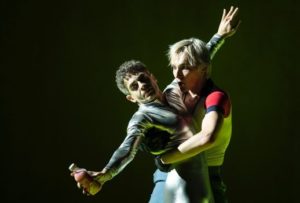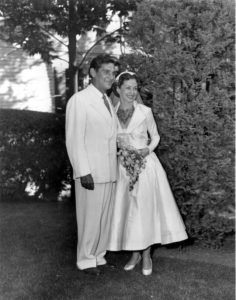
ANNANDALE-ON-HUDSON – The pre-performance corridors of the Fisher Center at Bard College appeared to have been invaded by The Radical Faeries – a madly colorful, gender-ambiguous subset of the gay community. Maybe it was a typical day in the life of a liberal campus? No. The cast of Christopher Alden’s production of Peter Pan – the Leonard Bernstein version – was revving up for the July 22 closing night at Bard Summerscape festival. By the end of the show, I don’t think there was really anything so gay about it, though it was great fun and offered a theatrical vision of life without gender.
Also, it happens to be one of three Bernstein Broadway scores that have gone missing and is the most likely candidate for reclamation.
And the others?
For all of its great music and epic sweep, the 1976 musical 1600 Pennsylvania Avenue will only be known for its excerpts in what is known as The White House Cantata. After 1600‘s Broadway failure, Bernstein took the show to Gore Vidal to see if it could be fixed. His reply: “The only thing to do is to take it to the Shrine of Lourdes because it needs a miracle.” And a minor miracle has happened: One of the show’s best songs, “Take Care of this House” (about The White House), has become an anthem for disillusionment in the Trump Era.
Something called “The Brecht Musical” (AKA The Race to Urga and The Exception and the Rule) was left unfinished around 1968, though in the years before Bernstein’s death, the creative team – including super-meticulous Stephen Sondheim and ever-prickly Jerome Robbins – reconvened to see if they could make anything of it at Lincoln Center. I once asked then-Lincoln Center Theater chief Bernard Gersten what went on amid all of that. After much prodding, he sighed, “Jerry kept making Lenny cry.” Enough said.
The 1950 Peter Pan seems to have had a comparatively peaceful gestation. This was not the classic Mary Martin version that came a few years later but more of a play with music starring Jean Arthur and Boris Karloff. Successful but forgotten, it stood a chance of rising again perhaps only in Bernstein’s 100th birthday year, during which most everything is up for revision. But any success in this revival couldn’t be measured by how Bernstein may or may not have envisioned it, since his involvement in the project wasn’t deep enough to require him to have a clear, comprehensive vision.
Bernstein was hired to write songs, not to collaborate from the ground up, as he had with other musicals such as On The Town. The songs were among his best at that time, but the show’s two stars couldn’t sing. Several songs, including the near-classic “Dream with Me,” went unused. Bernstein had conducting duties in Europe, so he entrusted Marc Blitzstein to make any necessary changes during the lead-up to opening night.
So the question is, with unused music and an untapped collaboration, what might this Peter Pan have been?
We do have a pretty clear idea as to what it was.
An original cast recording survives with large portions of the J.M. Barrie play, reminding us that, in many ways, the story was a Victorian version of what we now call “magic realism.” We accept that, in this lower-middle-class household, the dog is the nanny. And that the fairy world was not a disputed part of the ecosystem. In fact, when Peter Pan loses his shadow because the household’s window slammed shut on him, it’s taken for granted that the detached shadow would be sensibly folded up and left in a drawer.
Bernstein wasn’t out to revolutionize Broadway, as he would some seven years later with West Side Story. But his favorite book was Alice in Wonderland, a cousin of sorts to Peter Pan, and the composer seemed to have particular fun with the music he wrote for the pirates: “Eat blood, drink blood, dream blood, think blood,” sings this rather more malevolent version of Captain Hook.
Cut to 2018: A stage director like Christopher Alden wasn’t going to miss blood cues like that. His production managed to be radically realistic – and at the same time radically unrealistic – in comparison to the comfy storybook setting of the original. Real and unreal worlds weren’t as far apart as Oz and Kansas for author Barrie; Alden’s vision brought them even closer together. Mr. Darling, the benevolent household patriarch played by William Michals, didn’t change costumes when he became Captain Hook but stripped down to a blood-spattered wife-beater shirt and carried a hook in one of his hands. This was more a Jekyll/Hyde effect – polarized personalities who exist in the same world. (Many of us have known fathers like that.)
Most fascinating was Never-Never Land. What if it really existed? A land of perpetually pre-pubescent boys who have had no socialization on what it is to be a boy? The publicity photos for the production suggested that Peter Pan was some millennial with a skate board. In fact, the portrayal by Peter Smith made me think of the post-apocalyptic world of the early Mad Max movies. Peter had shaggy bleached hair that made him look older than boyish; he wore pants he had clearly grown out of and a scruffy mink coat. And he wasn’t at all self-conscious about it.
The other boys were similarly slapdash creatures who hadn’t the slightest idea of one gender or another. Ironically, the main dose of reality came from Tinker Bell, a male dancer (choreographer Jack Ferver) in skin-tight silver lamé whose facial expressions was sort of a smirking commentary on what went on, not to mention a source of raw sexuality to which the boys were oblivious. Their dancing tended to be barely-under-control flailing limbs. Even after the heroine Wendy (Erin Markey) is kidnapped and agrees to be the mother of the lost boys, she longs for a greater intimacy with Peter, since, after all, she is growing up. He seems not to understand it at all.
One of the central images of Marsha Ginsberg’s striking chartreuse production design was a carnival ride that goes only in a circle, suggesting how the lost boys do not have lives that are progressing. Though the Bard production has a certain amount of same-sex touching, I don’t get that it’s about homosexuality: it’s about how the sexual life force that we all live by was strangely absent in the ultimately sterile Never-Never Land.

Some have suggested that this Peter Pan’s subtext was about Leonard Bernstein not wanting to be heterosexual. It’s a nice theory, considering that the show was written on the verge of his marriage to Felicia Montealegre. Bernstein was perpetually boyish and couldn’t have known that his most-productive years would be within the family life that she gave him. If such an undercurrent existed, it may have given him the impetus to make his Peter Pan score something well beyond drudge work. And Bernstein may have indeed needed the work. McCarthyism began in 1950, Bernstein was considered a suspicious character, and by 1953, he wrote Wonderful Town (he once told me) for the money.
What makes Bernstein’s Peter Pan score something worth this high-concept, relatively-high-budget production is not any great feat of musical transcendence. Rather than conforming to the Broadway norms of 1950, he circumvented them. No mambo numbers to please the choreographer. No rousing Act II openers. The pirate music – sort of a fake sea chanty – comes close to being a showstopper, but functions mainly to tell you about the characters.
In contrast to Bernstein’s Mass, whose score is heavily burdened with the social and political issues of its time, and seems dated because of it, the Peter Pan songs gain their universality from their lack of self-consciousness, Bernstein was relatively free of artistic responsibilities and was communicating with an unaffected directness. It’s an important chapter in the Bernstein output. He found that Never-Never Land zone again periodically, even at the end of his life in portions of the song cycle Arias and Barcarolles. And in some ways, this less-assuming manner may be the most personal Bernstein music of all..

